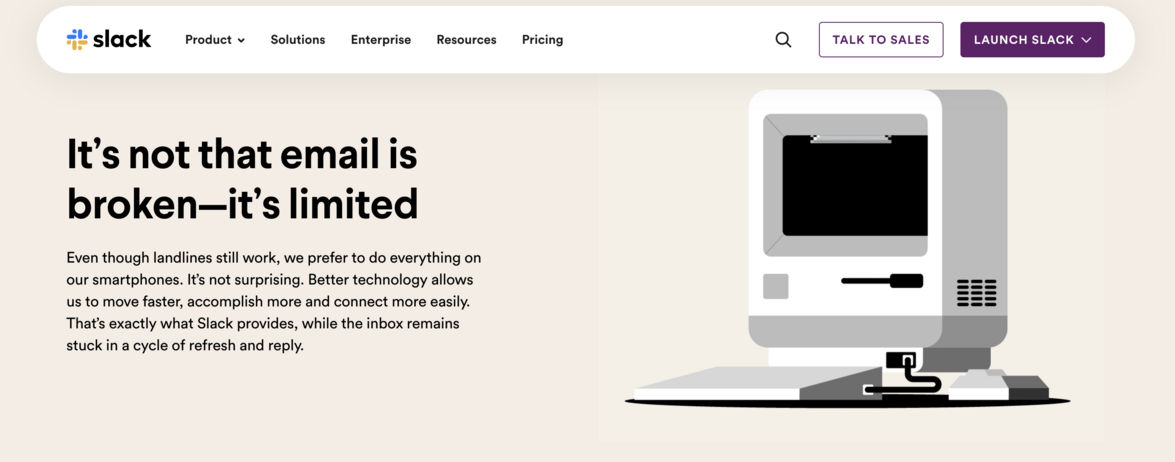Blog
Writing great content for your tech brand: 3 steps to get started
Writing great content for tech isn't easy — especially if your product is complicated.
Here are your first 3 steps to creating a strong written brand.

When it comes to competing in tech, your written brand goes a long way. Turns out it’s not just a great sales tool — it’s an effective way to:
A great written brand is what lies behind the success of tech giants like Slack — because who doesn’t love how it writes to you? Simple, personal … a software tool that talks to you like a friend.

But when it comes to writing for your own tech brand, you might’ve asked yourself: where do I even start?
We get it. Content writing for tech can be challenging — especially because your product or service might seem complicated. Over the years that our team at Say it right has worked with clients, these are the most common roadblocks we’ve seen tech players face:
Sound familiar? No worries. Below we cover what to tackle first when it comes to improving how you (and your team) write.

A brand’s tone & style isn’t just what it writes and speaks — but how: the words, phrases, sentence structure and tone we use to influence people's perception of us. It's also an opportunity to deliver an incredible user experience and build a solid relationship.
Wondering what a strong brand tone & style looks like? Here’s an example from one of our very own clients, Userbrain:

In just a few sentences, Userbrain makes it clear who they’re trying to reach and how they’re going to help. Communicating a brand impression that’s relaxed, professional and focused on building trust. And it wouldn’t be possible without well-documented brand tone & style guidelines.
The tone & style is the very first thing we tackle with our clients. Because we’ve seen first-hand that if you don’t set a strong baseline, you’re setting yourself up for failure.
To define this guideline, we’ll do a tone & style workshop — diving deep into the brand, including the company’s story, goals, USPs and more.
Once we’re done, we flesh out what we call a tone & style guideline. This is a go-to doc for the company or product descriptions, grammar and style rules, as well as copywriting examples to go by.
Unsure what points your brand tone of voice guidelines should cover? Here’s some inspiration. We set up our clients’ brand communications for success with our very own brand tone & style guideline template on Notion:
When clients reach out to us, we set up their very own Notion workspace and work together to create well-documented brand tone & style guidelines. Want to DIY yours? Check out our Brand Tone & Style Guide Notion template & video tutorial.

Setting up your brand tone & style guide is step one. Step two: Use it consistently, especially throughout your brand core. We’ve defined this as your company’s:
Improving your written brand core takes time. We recommend giving yourself at least a month to take care of steps one and two, depending on your resources. But trust us; the results will be worth it.

Once you’ve set a strong baseline with a tone & style guideline, as well as updated your written brand core, it’s time to tackle your content.
Consistently writing and publishing content is a sure way to establish a strong brand voice and make it more visible. We’ve found the best way to do this is to set up a simple content strategy. A simple document that helps you define your audience, channels and the minimum amount of content you want to produce and publish every single month.
The catch? Content marketing can be time-consuming, resource intensive and pretty damn overwhelming. But small steps go a long way — and you can set yourself up for success by setting your bar low (yup, we’re going against what the Gary V. hustle culture says). This means quality over quantity.

Writing great content for tech isn’t always easy — but we hope you feel a bit more confident now.
Here’s a quick recap of the 3 steps we covered:
Improving or creating a strong written brand is something you’re not going to regret. Because people don’t just want a pretty brand any more; they want to know what you stand for and expect nothing but the best user experience.
Want to learn more? Subscribe to our monthly newsletter below, where we share the best tips on how to leverage content for your tech company.